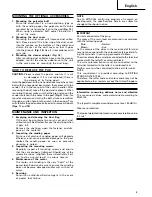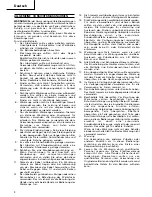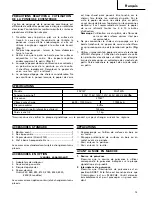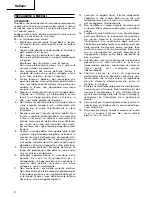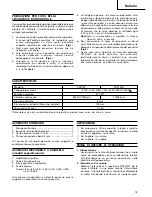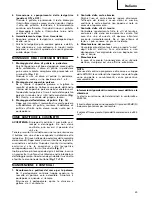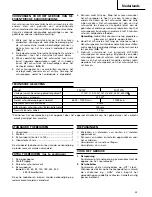
English
8
MOUNTING THE OPTIONAL ACCESSORIES
1. Mounting the polyester buff
Since the attachment is a hook-and-loop type as
with the sanding paper, the polyester buff can be
mounted by just pressing it onto the pad
(Fig. 14)
.
When using a polyester buff, adjust the dial to 1
– 3 on the scale.
2. Mounting the dust cover
Mounting the dust cover will improve dust collec-
tion. Place a part of the inner ring of the dust cover
into the groove on the bottom of the sander and
stretch the rest of the dust cover so that it goes
into the groove.
(Fig. 15)
Use it in accordance with
your job.
3. Mounting the cleaner adapter (Fig. 16)
After mounting dust collector hose onto the cleaner
adapter, mount the cleaner adapter onto the unit
in the same way as mounting the dust bag.
HOW TO REPLACE THE PAD
CAUTION:
Please replace the pad as soon as it is cut
or damaged. If it is not replaced, there is
the danger of its flying apart.
Hold the pad down with one hand and remove the center
bolt with the hexagonal bar wrench that comes with the
sander. (It is in the rear part of the switch handle.) After
removing the bolt, take off the pad and replace it. When
mounting the pad, make sure that the protrusions on the
sander match with the holes in the pad.
(Fig. 17)
Also, for
more leverage when turning the bolt, stick a screwdriver
through a suction hole into the notch in the housing. This
will stabilize the pad and make it easier to remove the bolt.
(Figs. 17
and
18)
MAINTENANCE AND INSPECTION
1. Emptying and cleaning the Dust Bag
If the dust bag contains too much saw dust, dust
collection will be affected. Empty the dust bag when
it gets full.
Remove the dust bag, open the fastener, and dis-
pose of the contents.
2. Inspecting the sanding paper
Since use of worn-out sanding paper will degrade
efficiency and cause possible damage to the pad,
replace the sanding paper as soon as excessive
abrasion is noted.
3. Inspecting the mounting screws:
Regularly inspect all mounting screws and ensure
that they are properly tightened. Should any of the
screws be loose, retighten them immediately. Fail-
ure to do so could result in serious hazard.
4. Maintenance of the motor
The motor unit winding is the very “heart” of the
power tool. Exercise due care to ensure the winding
does not become damaged and/or wet with oil or
water.
5. Servicing
Consult an authorized Service Agent in the event
of power tool failure.
NOTE
Due to HITACHI's continuing program of research an
development, the specifications herein are subject to
change without prior notice.
IMPORTANT
Correct connection of the plug
The wires of the main lead are coloured in accordance
with the following code:
Blue:
–Neutral
Brown:
–Live
As the colours of the wires in the main lead of this tool
may not correspond with the coloured markings identify-
ing the terminals in your plug proceed as follows:
The wire coloured blue must be connected to the terminal
marked with the letter N or coloured black.
The wire coloured brown must be connected to the
terminal marked with the letter L or coloured red.
Neither core must be connected to the earth terminal.
NOTE
This requirement is provided according to BRITISH
STANDAR 2769: 1984.
Therefore, the letter code and colour code may not be
applicable to other markets except The United Kingdom.
Information concerning airborne noise and vibration
The measured values were determined according to
EN50144.
The typical A-weighted sound pressure level: 80 dB (A)
Wear ear protection.
The typical weighted root mean square acceleration value:
3.0 m/s
2
.
Summary of Contents for FSV 13Y
Page 2: ...1 1 2 3 4 5 6 7 8 9 10 1 2 3 4 5 6 7 8 9 0 A ...
Page 3: ...11 13 12 14 15 16 17 18 2 B C D E F M I J K L H G ...
Page 5: ......
Page 30: ......
Page 31: ......
Page 32: ......
Page 33: ......
Page 34: ...33 ...
Page 36: ...35 ...
Page 37: ...36 ...









